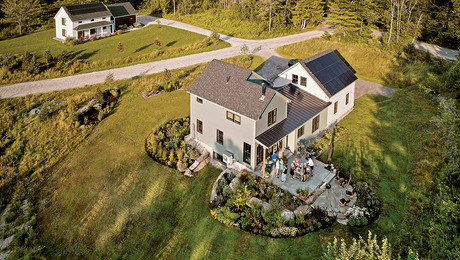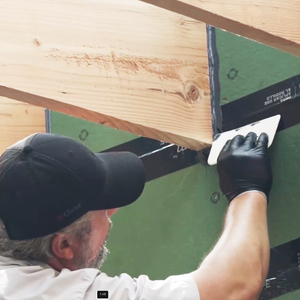Outbuilding Electricity supply
Hello all,
I’m going to be building a shed out back of my house. I want to get electricity to the site before I get the crushed stone that I’m going to put under the foundation.
I read the quick article in Fine Homebuilding about getting electricity to the outbuilding – Underground rated cable with PVC conduit when it enters or exits the ground, buried 1 foot deep.
I’m a little concerned about just burying the cable – does anybody put this stuff in PVC conduit all the way through? Do I have to worry about water getting in the conduit? Flexible or rigid?
The article showed some kind of bushing on the end of the 90 degree bend of the conduit as it exits underground – do I really need this? Didn’t see any bushings in my big box store.
Any replies greatly appreciated,
Ben


















Replies
Direct burial cable is rated for exactly that, and has a long history for safe and reliable use. You do need to make sure it's buried deep enough, and I think that code requires 18" in some cases, so you want to verify the proper depth (keeping in mind that it never hurts to go deeper).
The one case where you might want to consider using conduit the whole way is if the soil is exceedingly rocky (with sharp rocks).
Obviously, if you use conduit for just the start and end of the run then water does get into the open ends of the conduit. But this is not harmful (so long as the conduit enters the structure above the "high water line").
You do need the bushings, at least to be code compliant. I believe (but stand to be corrected) that your basic box bushing will do the trick -- what's wanted is simply the radiused opening that would normally face the inside of the box, to eliminate any sharp edges bearing on the wire.
First, a few corrections:
Direct burial cable is required to be buried deeper than conduit; in this instance, I believe 24" is called for.
Then the cable needs to enter boxes, etc., with the proper fittings. These fittings will provide strain relief as well as protecting the cable from abrasion. The problem with these fittings is that they are (often) not listed for outdoor use. Pay attention to the details.
From a design standpoint, what's 'legal' isn't always smart. This forum is replete with threads where someone wants to make a change six months later, and doesn't want to dig up and replace the wire they just ran. Run pipe, and all is well- you can easily replace or add wires without digging anything up.
Some day you will want to dig in your yard. It might be for a fence or for a tree, but you (or someone) will dig. So, take impeccable notes and make a map. It won't hurt to put caution tape 6" above the wire or conduit also.
i gots 'bout 20 sheds with power,
alla da feeders are 2-3 ft deep sintz i gots mah own backhoe,
after backfill of about 6 " i throw whaterver trash is around on top as a warning nex time ah digs somethin', tin cans, drywall ends, lumber with rot, rusted fence or wire rope, jimmy hoffa, etc......
Have found that old worn out extension cords that osha wont letcha us onna job site with some tar on the bad spots makes grate unnergrnd feeders........ some have lasted 30 year......
No backhoe for me unfortunately. That ground is cold and hard, so I am having to work for 12 inches deep. I think I will put some conduit over the part that does run under my lawn (only about 12 feet) and leave the rest as is.
Thanks for all the replies,
Ben
Of course, JH has had several dogs mysteriously drop dead while walking across the yard.
these guys tried to dig some Cu up ofr scrap....
If you want to be legal, the rule is
PVC conduit at 18"
Direct bury cable at 24"
or if this is GFCI protected, in a residential yard
a single circuit 120v 20a or less it can be 12" (cable or PVC)
I saw that FH article, and I had some reservations about it then. I'd like to take a big step back, and approach this job from a fresh perspective.
First off, be HONEST with yourself. Just what do you really wnat to accomplish? Simply put a light and plug out there ("just in case"), or are you building a workshop/ "man cave?" How likely is it that your needs will change over time?
Secondly, I HATE digging. So, I make sure I don't have to do it more than once. This means: a foot-wide trench, 30" deep, with a nice bed of sand both under and over the oversize pipe(s) I place in it.
You want it deep, at least as deep as a full-size shovel blade, so it doesn't get hit whenever the yard sprinklers need fixing. Deeper is better. The FH article was simply wrong about the 12" depth; such would be possible only if there was also some feature that guaranteed that the area would not even be walked upon, ever.
You want pipe(s) because cables eventually either break, or you want more power and need bigger wires. Use pipe and you can just pull in the new wires. As for using extension cord material? Forget it; some soils will very quickly eat up that rubber, leaving you with bare wires underground. The bigger the pipes, the easier the pull.
You want two pipes, as someday you'll want a phone, or TV, or sprinkler controls, or some other sort of low-voltage wire out there. Why dig twice when pipe is cheap?
If you're running more than one circuit, or plan to have a panel out there, you will also need a ground rod at the shed. You'll also probably need a disconnect switch on the outside of the shed.
Where the pipes exit the ground, extra protection is required. PVC should be at least Schedule 80. If you're using rigid steel conduit, you'll want to wrap it in pipe tape- especially the first 12" in the ground. A common practice is to use steel for the elbows and the uprights, and PVC for the horizontal run in the bottom of the trench.
Bringing power to a shed is often a 'tripping point' where a permit is required.
Thanks for the suggestions.
I'm not going to need a man-cave. I do want to avoid pulling a permit if possible. The shed is a long way from the house, and pulling cable over that distance would be a tough sell.
I think Junkhound was kidding, and I plan to use good underground rated cable in any case, conduit or no.
Just looking for a light and an occasional place to plug in a skill saw when the need arises.
Finally, just realized that the pool shed is much closer than the house - That shed has it's own panel for the pump motors and some GFCI breakers for some outside outets - I may go 20 feet lateral rather than 50 feet back to the house.
Thanks
Ben
Heck, 20 feet is only a couple of lamp extension cords -- easy!
A permit is required if there is power.
In most jurisdiction a permit is required beginning at either 100 or 120-square feet of "shed".
Almost all jurisdictions require a permit if there are permanent provisions for power, water or sewer.
I got in trouble once because I had installed a 30-amp plug in the garage, and would feed my shed that had an RV style hookup receptacle, and was wired.